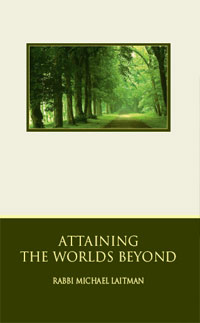Step 1: Beginning the Process of Self-Correction
On the spiritual path first we need to achieve the correction of the creation, that is the congruence of our personal qualities with the qualities of the Creator, and only then can we begin to achieve the goal of creation, to receive from the Creator unlimited pleasure, unbounded by the limits of egoism.
Before the correction, we possess only the desire for selfish gratification. As we progress in correcting ourselves, we start to favor the desire to give everything away over the desire to receive pleasure for ourselves.
However, at this stage we are still incapable of receiving pleasure from the Creator.
Step 2: Realizing What Awaits in the Future
Only upon completing the process of self-correction can we begin to receive unbounded pleasure, not for the sake of our own egoism, but for the sake of the goal of creation.
The gratification that we receive not for the sake of our own egoism does not generate feelings of shame, because by receiving, by grasping, and by perceiving the Creator, we are happy for the pleasure He receives. Thus, the more we receive from the Creator and are pleased by Him, the happier we are that the Creator experiences pleasure as a result.
Step 3: Navigating Darkness and Light
We can make an analogy between light and darkness in our world by referring to perceptions of the spiritual Light and darkness (day and night). This is the feeling of presence or absence of the Creator, of the presence or the absence of the Creator’s supervision; or, “the presence or the absence of the Creator” within ourselves.
In other words, if we were to ask something of the Creator and receive it immediately, this is denoted as “Light”, or “Day”. But if we are plagued by doubts about the existence of the Creator and about His management of the universe, this situation is called “darkness,” or “night.”
To better phrase it, the concealment of the Creator is known as “darkness, “since it arouses in a person doubts and incorrect thoughts, which are felt by him as the darkness of the night.
Step 4: Placing Faith above Reason
Our true goal should not be to perceive the Creator and grasp His actions, since this, in itself, is a purely egoistic desire. A human being will not be able to withstand the enormous pleasure resulting from the attained perceptions and will return to the egoistic state.
The real objective should be the desire to receive from the Creator the strength to proceed against the yearnings of the body and the mind, that is, to attain faith that will be greater than the human intellect and bodily desires. Having grasped and perceived the Creator and His absolute benevolent dominion, as well as His power in the entire creation, we should choose not to see the Creator in all His glory, because this would undermine our faith.
Rather, we should proceed by virtue of our faith and against the desires of the body and human intellect. All that we can desire is the strength to believe in Him and in His Dominion of the universe. The possession of such a belief is known as “Light,” or “Day,” since we can begin to receive pleasure without fear, being free from the desires of the body, and not being enslaved by our bodies and our reason.
Step 5: Forming a True Prayer
When we achieve this new nature, that is, when we are capable of carrying out acts independent of our bodily desires, the Creator gives us pleasures from His Light. If darkness descends on us, and we do not feel any joy in the work of attaining the spiritual nor the ability to feel a special relation with the Creator and to feel fear and love for Him, then we have but one alternative: the crying of the soul.
We must pray to the Creator so that He should have pity on us and remove the black cloud that darkens all of our feelings and thoughts, concealing the Creator from our hearts and eyes. This is because the cry of the soul is the most powerful prayer.
When nothing can help, when we are convinced that all our efforts, knowledge, experience, physical acts and endeavors are inadequate to help us enter the Upper Spiritual Realm; when with our entire being we feel that we have exhausted all possibilities and all powers, only then do we realize that only the Creator can help; only then do we come to cry out to the Creator and pray to Him for personal redemption.
Step 6: Reaching the “Gate of Tears”
But before this time, no extraneous hardships will induce us to cry out to the Creator genuinely and from the bottom of our hearts. Only when we feel that all the options before us are already closed will the “gates of tears” open, so that we may enter the Higher World, the dwelling of the Creator.
Because of this, after we have tested all possibilities to attain spiritual ascent by ourselves, a state of absolute darkness will descend upon us. There is only one escape— only the Creator can help us. But still in the breaking of the egoistic “I,” when we have not yet achieved the perception that there is a Force that guides and directs us, when we have not yet been cured by this truth and have not yet apprehended the state, our bodies will not yet allow us to call out to the Creator.
And because of this we are obligated to do everything in our strength we can, and not to wait for a miracle from Above. This is not because the Creator does not wish to take pity on us and is awaiting a “breaking point.”
When we try out all our options, we gain experience, understanding and perception of our own nature. The feelings we have passed through are necessary because it is in them that we receive, and it is with them that we sense, the Revelation of the Light of the Creator and the Upper Intellect.
 “The 6 Steps of Spiritual Correction ” is based on the book, Attaining the Worlds Beyond by Dr. Michael Laitman.
“The 6 Steps of Spiritual Correction ” is based on the book, Attaining the Worlds Beyond by Dr. Michael Laitman.

